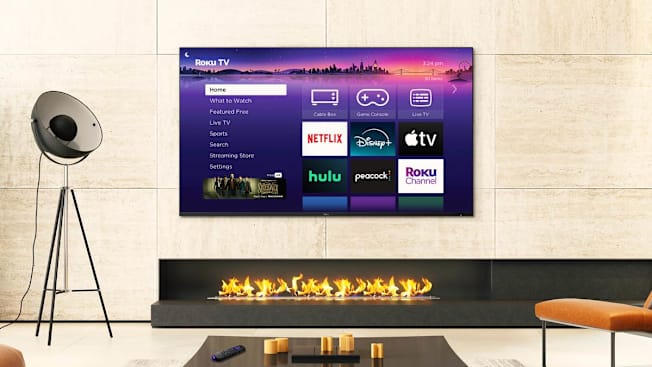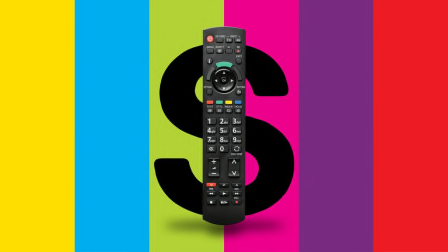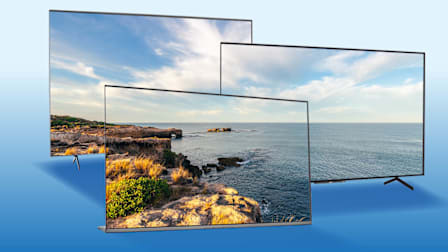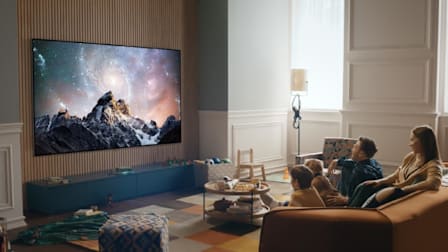Which Roku TV Made by Roku Should You Buy?
CR tests new Roku Pro, Plus, and Select sets for key factors like overall picture quality, HDR, sound, and viewing angle
When you shop through retailer links on our site, we may earn affiliate commissions. 100% of the fees we collect are used to support our nonprofit mission. Learn more.

Roku TVs have been available for several years from a sizable roster of brands, including Hisense, Insignia, and TCL. But last year, as both Hisense and TCL shifted more sets to the Google TV platform, shoppers started seeing the first Roku TVs designed and made by Roku itself. And the company added more in 2024.
Roku Select TVs
You’ll find the most basic Roku TVs in the Roku Select series. These TVs are available in screen sizes ranging from 32 to 75 inches. Prices start at about $140 for a 720p model and run up to just under $600 for the biggest set. You can buy the 65-inch Roku 65R4A5R right now for about $400 at several retailers, including Amazon, Best Buy, and Walmart.
All the Select models support the HDR10 and HDR10+ HDR formats and include an auto-brightness feature that uses light sensors to adjust the TV’s brightness to the room’s ambient light conditions. These TVs lack full-array LED backlights with local dimming, which are found on the Plus Roku TV models. The majority of Roku Select TVs do well for overall picture quality but have a number of shortcomings. (CR members can see detailed test results below.)
Roku Plus TVs
Not surprisingly, we see performance improve as we move up in Roku’s product line. All three of the Roku Plus models we tested—the 75-inch Roku 75R6A5R, the 65-inch Roku 65R6A5R, and the 55-inch Roku 55R6A5R—score significantly higher overall than the Roku Select models. Prices for these sets range from about $450 to $800.
When you step up to a Roku Plus set, you get a QLED TV, which uses quantum dots rather than filters to produce colors. These tiny nanocrystals have the potential to produce brighter, more saturated colors than sets that use conventional LED backlights.
The Roku Plus models also have full-array LED backlights with local dimming, where individual zones on the TV can be lit or dimmed separately. That can help improve contrast and black levels. Unlike the Select models, Roku Plus TVs support Dolby Vision high dynamic range (HDR) and Dolby Atmos sound, and come with a later version of WiFi (WiFi 6) than the Select sets. (Tech companies are already onto WiFi 7, but don’t worry about it.) Plus there’s a rechargeable Roku Voice Remote Pro, so you don’t have to keep replacing batteries. Select models come with a more basic remote control. These sets also offer much better sound than the Select models.
Roku Pro Series TVs
The 65-inch Roku Pro series model we tested is the best-performing Roku-made TV we’ve had in our labs.
Like the Plus sets, the Pro series models are offered in 55-, 65-, and 75-inch screen sizes, but here the prices range from about $800 to $1,500.
Pro series models are the first Roku-made sets to include Mini LED backlights with local dimming, an important TV innovation of the past few years. Mini LED sets use hundreds (and in some cases, thousands) of very tiny LEDs, which can be grouped into large numbers of local dimming zones. This can improve black levels and contrast, as well as overall brightness, and help reduce halos around bright objects that are displayed against a dark background.
Another feature unique to the Pro series includes the use of AI and machine learning to help improve picture quality. A feature called Smart Picture (see the photo below) will automatically adjust picture and audio settings based on the type of content you’re watching.
Pro models also support Dolby Vision IQ, and Dolby Atmos sound. The Pro series sets have the potential to work well for gaming, thanks to a higher 120Hz native refresh rate, which can help reduce motion blur during fast-moving scenes; AMD FreeSync Premium Pro support; VRR (variable refresh rates); and ALLM (auto low-latency mode). The sound system gets a boost, thanks to side-firing Dolby Atmos speakers.
The TVs come with WiFi 6 and the Roku Voice Remote Pro rechargeable remote control, which includes a lost remote finder feature. They also have a new, more modern design that rests flat against the wall when mounted. And Roku’s new Backdrops feature lets you display artwork or family photos on the set when you’re not watching TV.
All Roku-branded TVs this year have an expanded audio ecosystem that can integrate with a Roku TV Wireless Soundbar, available on the Roku website, as well as a wireless subwoofer. The Plus and Pro TVs include Bluetooth for connecting to wireless headphones for private listening.
The Roku TV Verdict
So is it smart to buy a Roku TV made by Roku or one from the other companies that make Roku-based TVs?
Based on the results of our tests, we think the new Roku Plus TVs are worth considering if you’re a fan of the Roku smart TV platform—as we are—as long as top-notch high dynamic range performance isn’t a critical attribute. If it’s very important to you, spring for a Pro series set, which is now the top-performing Roku TV in our ratings.
As a result of our experience with the 65-inch model, a Roku Select TV could be a good choice for those who want to spend less. Just know that you’ll be sacrificing HDR performance, and it would be useful to get a soundbar to overcome the TV’s poor built-in sound.
How CR Tests TVs
The TV test team at Consumer Reports puts every TV through a battery of tests in our TV labs.
We first set up each TV and carefully note all its key features, such as resolution, number of HDMI inputs, and support for streaming services and voice-enabled digital assistants. We adjust the TV for optimal performance using the set’s built-in presets and picture controls. We use objective tests and measurements, as well as real-world video clips and subjective evaluations, to determine picture detail, color accuracy, and contrast.
In our tests with sets that support HDR, we use a variety of test patterns that tell the TV to illuminate defined parts of the image with specific brightness levels, including 100 nits, 250 nits, and 1,000 nits. (Nits are the units used to measure TV brightness.) We also have a 4,000-nit pattern, though no TVs can currently hit that target, and most real-world HDR content maxes out at 1,000 nits.
At Consumer Reports, TV ratings are based on hundreds of data points recorded by testers. Our ratings currently include more than 300 sets.
The test patterns we use help us determine how accurately a TV can track the metadata in the HDR signal and hit these specific brightness levels. We’ve found that both the Plus and Pro series sets boost brightness slightly in the mid-tone regions, represented by the 100- and 250-nit patterns. The Select and Plus sets lack sufficient brightness to fully illuminate the 1,000-nit pattern.
We also compare each TV with one of several fully calibrated reference TVs in our labs. In addition to HDR, our tests include evaluations for viewing angle and sound quality, along with other factors. We also have data privacy and security scores for all the TVs we test. Now that TVs routinely connect to the internet, these have become concerns for consumers. Consumer Reports encourages TV makers to ship their sets to consumers with the optimal privacy settings turned on by default. You can also adjust the settings yourself.
































